英语语法大全之语法结构图
- 格式:pptx
- 大小:295.51 KB
- 文档页数:2
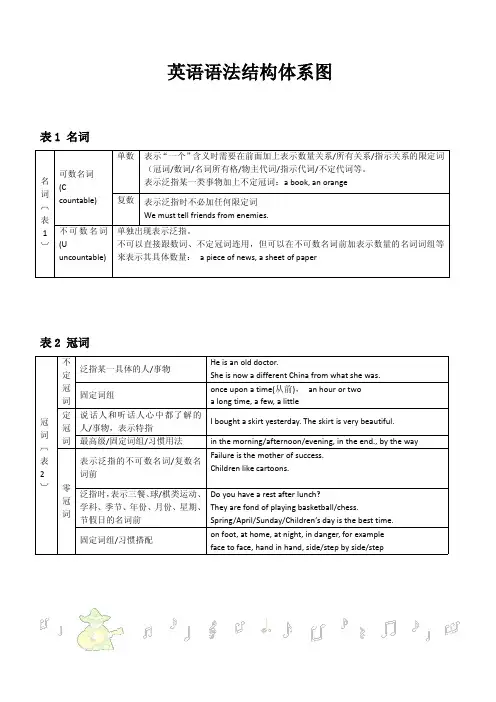

初中英语语法网络图一.名词I. 名词的种类:专有名词普通名词国名.地名.人名,团体.机构名称可数名词不可数名词个体名词集体名词抽象名词物质名词II. 名词的数:1. 规则名词的复数形式:名词的复数形式,一般在单数形式后面加-s或-es。
现将构成方法与读音规则列表如下:规则例词1一般情况在词尾加-s map-maps, sea-seas, girl-girls, day-days2以s, x, ch, sh结尾的名词后加-es class-classes, box-boxes, watch-watches, dish-dishes3以-f或-fe结尾的词变-f和-fe为v再加-esleaf-leaves, thief-thieves, knife-knives, loaf-loaves,wife-wives加-sbelief-beliefs, chief-chiefs, proof-proofs, roof-roofs,gulf-gulfs4以辅音字母加y结尾的名词,变y为i加-esparty-parties, family-families, story-stories,city-cities5以元音字母加y结尾的名词,或专有名词以y结尾的,加-stoy-toys, boy-boys, day-days, ray-rays,Henry-Henrys6以辅音字母加-o结尾的名词一般加-eshero-heroes, Negro-Negroes, potato-potatoes,tomato-tomatoes不少外来词加-spiano-pianos, photo-photos, auto-autos, kilo-kilos,solo-solos两者皆可zero-zeros/zeroes, volcano-volcanoes/ volcanos7以元音字母加-o结尾的名词加-s radio-radios, bamboo-bamboos, zoo-zoos8以-th结尾的名词加-s truth-truths, mouth-mouths, month-months, path-paths,2. 不规则名词复数:英语里有些名词的复数形式是不规则的,现归纳如下:规则例词1改变名词中的元音字母或其他形式man-men, woman-women, foot-feet, goose-geese, mouse-mice2单复数相同sheep, deer, series, means, works, fish, species li, yuan, jin,3只有复数形式ashes, trousers, clothes, thanks, goods, glasses, compasses, contents4一些集体名词总是用作复数people, police, cattle, staff5部分集体名词既可以作单数(整体)也可以作复数(成员)audience, class, family, crowd, couple, group, committee,government, population, crew, team, public, enemy, party6复数形式表示特别含义customs(海关), forces(军队), times(时代), spirits(情绪), drinks(饮料), sands(沙滩), papers(文件报纸), manners(礼貌), looks(外表), brains(头脑智力), greens(青菜), ruins(废墟)5疑问代词who, whom, whose, which, what, whoever, whichever, whatever 6关系代词that, which, who, whom, whose, as7不定代词one/ some/ any, each/ every, none/ no, many/ much, few/ little/ a few/ a little, other/ another, all/ both, neither/ eitherII. 不定代词用法注意点:1. one, some与any:1) one可以泛指任何人,也可特指,复数为ones。
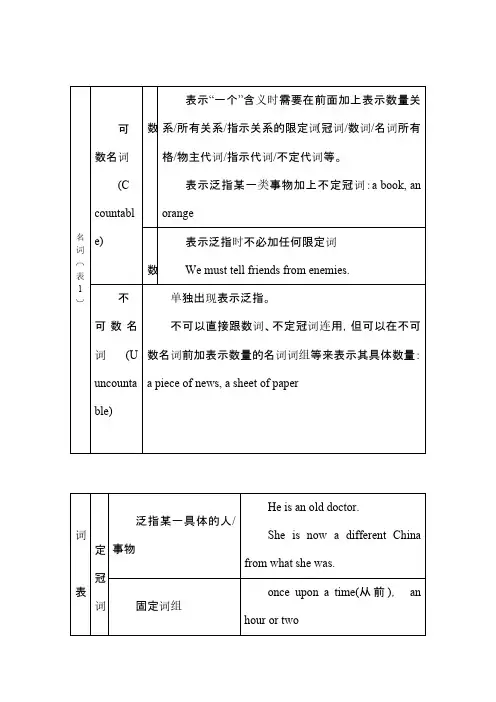
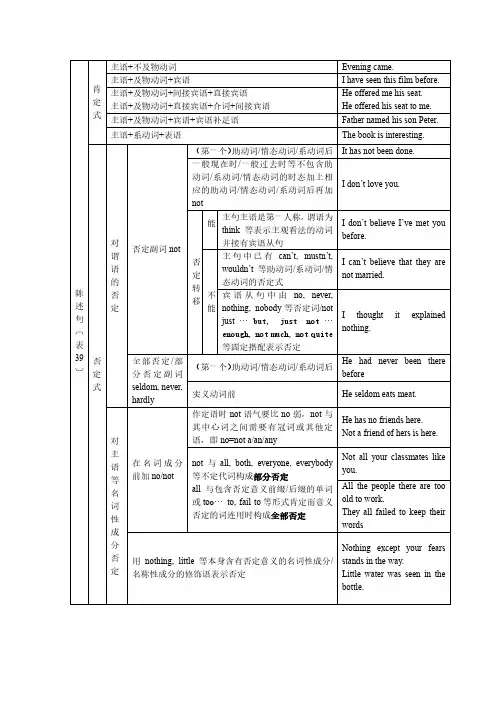
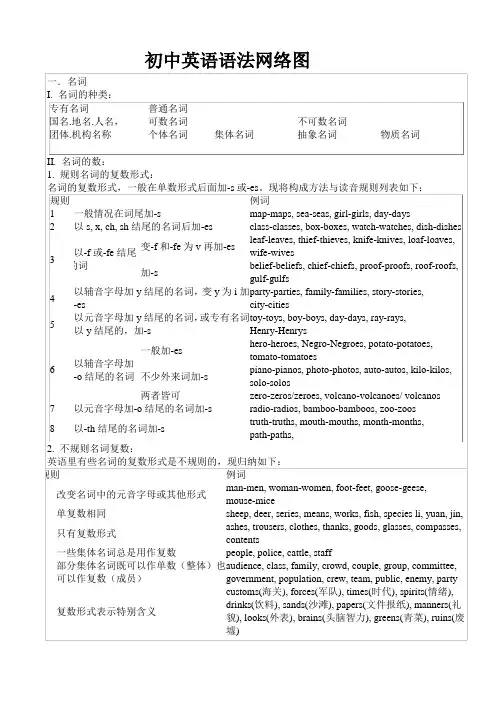
初中英语语法网络图一.名词I. 名词的种类:专有名词普通名词国名.地名.人名,团体.机构名称可数名词不可数名词个体名词集体名词抽象名词物质名词II. 名词的数:1. 规则名词的复数形式:名词的复数形式,一般在单数形式后面加-s或-es。
现将构成方法与读音规则列表如下:规则例词1一般情况在词尾加-s map-maps, sea-seas, girl-girls, day-days2以s, x, ch, sh结尾的名词后加-es class-classes, box-boxes, watch-watches, dish-dishes3以-f或-fe结尾的词变-f和-fe为v再加-esleaf-leaves, thief-thieves, knife-knives, loaf-loaves,wife-wives加-sbelief-beliefs, chief-chiefs, proof-proofs, roof-roofs,gulf-gulfs4以辅音字母加y结尾的名词,变y为i加-esparty-parties, family-families, story-stories,city-cities5以元音字母加y结尾的名词,或专有名词以y结尾的,加-stoy-toys, boy-boys, day-days, ray-rays,Henry-Henrys6以辅音字母加-o结尾的名词一般加-eshero-heroes, Negro-Negroes, potato-potatoes,tomato-tomatoes不少外来词加-spiano-pianos, photo-photos, auto-autos, kilo-kilos,solo-solos两者皆可zero-zeros/zeroes, volcano-volcanoes/ volcanos7以元音字母加-o结尾的名词加-s radio-radios, bamboo-bamboos, zoo-zoos8以-th结尾的名词加-s truth-truths, mouth-mouths, month-months, path-paths,2. 不规则名词复数:英语里有些名词的复数形式是不规则的,现归纳如下:规则例词1改变名词中的元音字母或其他形式man-men, woman-women, foot-feet, goose-geese, mouse-mice2单复数相同sheep, deer, series, means, works, fish, species li, yuan, jin,3只有复数形式ashes, trousers, clothes, thanks, goods, glasses, compasses, contents4一些集体名词总是用作复数people, police, cattle, staff5部分集体名词既可以作单数(整体)也可以作复数(成员)audience, class, family, crowd, couple, group, committee,government, population, crew, team, public, enemy, party6复数形式表示特别含义customs(海关), forces(军队), times(时代), spirits(情绪), drinks(饮料), sands(沙滩), papers(文件报纸), manners(礼貌), looks(外表), brains(头脑智力), greens(青菜), ruins(废墟)7不定代词one/ some/ any, each/ every, none/ no, many/ much, few/ little/ a few/ a little, other/ another, all/ both, neither/ eitherII. 不定代词用法注意点:1. one, some与any:1) one可以泛指任何人,也可特指,复数为ones。
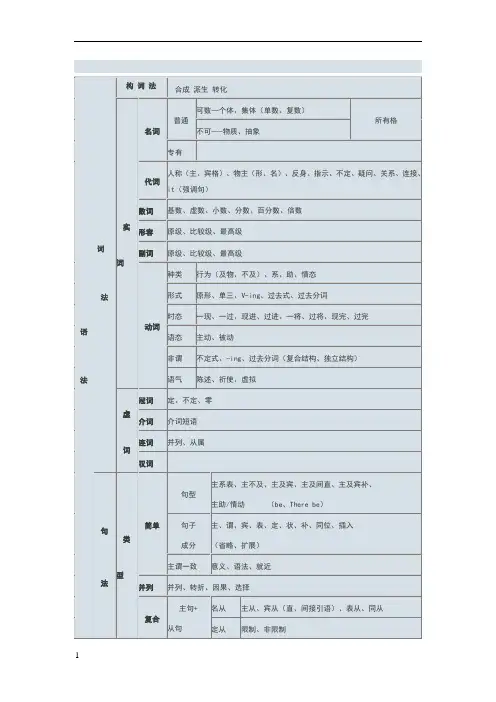
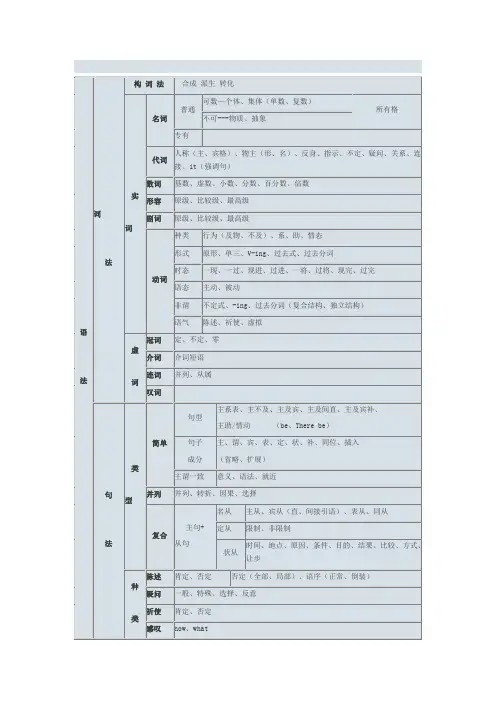
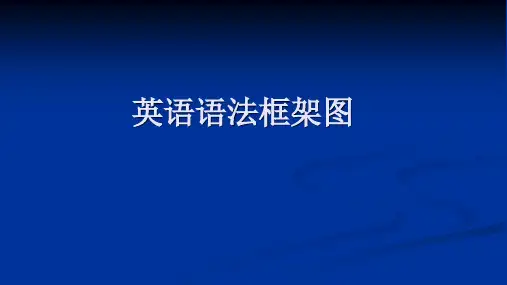
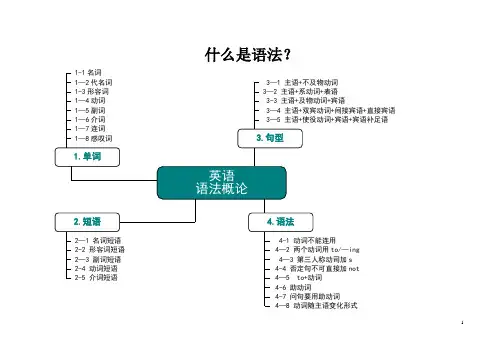
什么是语法?+表语+宾语+间接宾语+直接宾语+宾语+宾语补足语to/—ingsnot一般现在时vs.一般过去时一般将来时将来时表示将来某个时间要发生的动作或存在的状态,也表示将来经常或者重复发生的动作,常与表示将来的时间副词连用,例如:soon,next week, this afternoon,tomorrowWe will graduate next year.我们明年毕业。
进行时(1)(V+ing)现在分词(V+ing)现在分词(V+ing)?进行时(2)完成时(1)Part1 完成时的句型构成1-1 陈述句型:S+has/have+过去分词(p。
p。
)I have already finished my homework.(我已经完成了我的作业)1-2 否定句型:S+has/have+not+过去分词(p。
p.)Sandy has been a nurse in this hospital for 15 years。
(珊蒂已经在这家医院担任护士长达15年了。
)1-3 疑问句型:Has/Have+s+过去分词(p。
p。
)?Have you ever seen Peter in past 3 months?(过去3个月内,你看见过彼吗?)2-1 陈述句型:S+had+过去分词(p。
p。
)This proposal had been deliverde by Eva before Aaron finished it。
(这个计划在艾伦完成以前,伊娃就已经提交出去了)2-2 否定句型:S+had+not+过去分词(p。
p。
)I had not finished my work when he visited me last week.(上周他来拜访我以前,我还没有完成工作。
)2-3 疑问句型:Had+s+过去分词(p。
p.)?Had you ever been to a blind date before you married?(你结婚以前曾经参加相亲吗?)3-1 陈述句型:S+shall/will+have+过去分词(p。
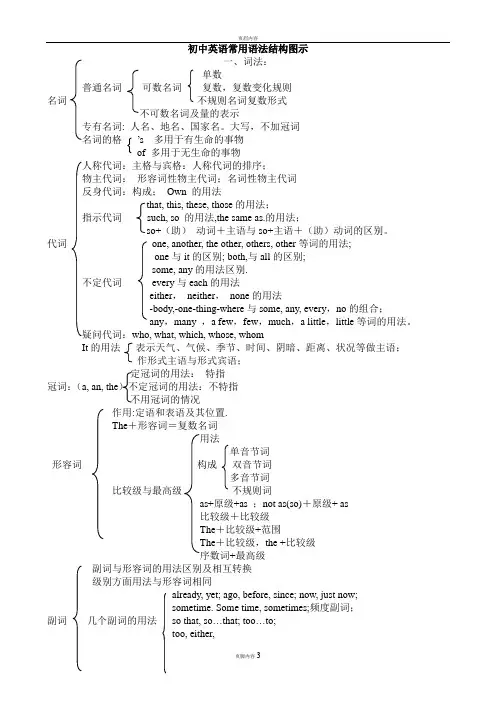
初中英语常用语法结构图示一、词法:单数普通名词可数名词复数,复数变化规则名词不规则名词复数形式不可数名词及量的表示专有名词: 人名、地名、国家名。
大写,不加冠词名词的格’s 多用于有生命的事物of 多用于无生命的事物人称代词:主格与宾格:人称代词的排序;物主代词:形容词性物主代词;名词性物主代词反身代词:构成;Own 的用法that, this, these, those的用法;指示代词such, so 的用法,the same as.的用法;so+(助)动词+主语与so+主语+(助)动词的区别。
代词one, another, the other, others, other等词的用法;one与it的区别; both,与all的区别;some, any的用法区别.不定代词every与each的用法either,neither,none的用法-body,-one-thing-where与some, any, every,no的组合;any,many ,a few,few,much,a little,little等词的用法。
疑问代词:who, what, which, whose, whomIt的用法表示天气、气候、季节、时间、阴暗、距离、状况等做主语;作形式主语与形式宾语;定冠词的用法:特指冠词:(a, an, the)不定冠词的用法:不特指不用冠词的情况作用:定语和表语及其位置.The+形容词=复数名词用法单音节词形容词构成双音节词多音节词比较级与最高级不规则词as+原级+as ;not as(so)+原级+ as比较级+比较级The+比较级+范围The+比较级,the +比较级序数词+最高级副词与形容词的用法区别及相互转换级别方面用法与形容词相同already, yet; ago, before, since; now, just now;sometime. Some time, sometimes;频度副词;副词几个副词的用法so that, so…that; too…to;too, either,everyday, every day, every other day;enough;at, in on;above, below, over, under, up, down;along, across, through;around, about;表示地点among, between;in front of, in the front ofbehind, before, after;to , towards, for;out of, from, into, off;介词in; on; at;for; since; during;表示时间till, until;during, for, through;since, from;till, by;表示原因: at, from, if;表示方式: by, in动词+介词:形容词+介词: be good at, be good to, be good for;介词+名词: on, about基数词:序数词:分数数词倍数加减乘除百分数年月日的表达小时与分钟的表达实义动词(行为动词);分类联系动词;助动词;情态动词主谓一致;动词不定式作定语,作宾语补足语动名词:与动词不定式的区别一般现在时:主+V(原、单三)+其他动词一般将来时:主+will+V(原)+其他一般过去时:主+V(过去时)+其他时态过去将来时:主+would +V(原)+其他现在进行时:主+am/is/are+Ving+其他过去进行时:主+was/were+Ving+其他现在完成时:主+have/has+p.p+其他过去完成时: 主+had+p.p+其他be going to结构:主+am/is/are/was/were/will be…+v原+其他。
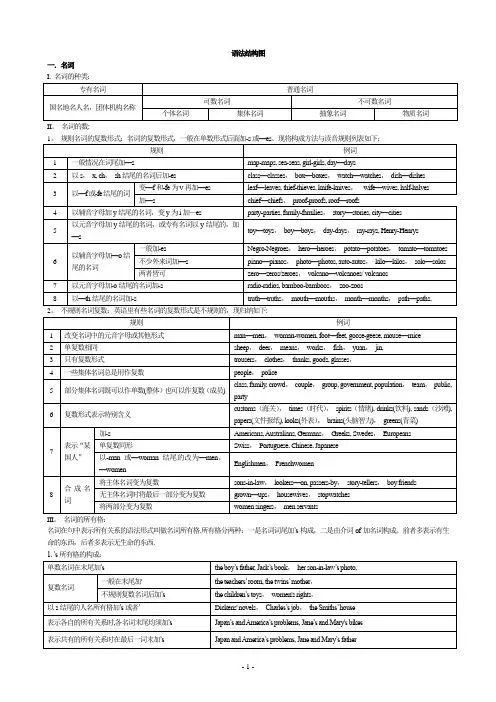
语法结构图一.名词II。
名词的数:III。
名词的所有格:名词在句中表示所有关系的语法形式叫做名词所有格.所有格分两种:一是名词词尾加’s构成,二是由介词of加名词构成。
前者多表示有生命的东西,后者多表示无生命的东西.3。
of所有格的用法:用于无生命的东西:the legs of the chair,the cover of the book用于有生命的东西,尤其是有较长定语时:the classrooms of the first-year students 用于名词化的词:the struggle of the oppressed二.冠词冠词分为不定冠词(a, an),定冠词(the),和零冠词。
三.代词:I。
代词可以分为以下七大类:II. 不定代词用法注意点:1。
one, some与any:1)one可以泛指任何人,也可特指,复数为ones。
some多用于肯定句,any多用于疑问句和否定句。
One should learn to think of others.Have you any bookmarks? No, I don’t have any bookmarks.I have some questions to ask.2) some可用于疑问句中,表示盼望得到肯定的答复,或者表示建议,请求等。
W ould you like some bananas? Could you give me some money?3)some 和any修饰可数名词单数时,some表示某个,any表示任何一个。
I have read this article in some magazine. Please correct the mistakes,if any.4)some和数词连用表示“大约",any可与比较级连用表示程度。
There are some 3,000 students in this school。
初中英语常用语法结构图示一、词法:单数普通名词可数名词复数,复数变化规则名词不规则名词复数形式不可数名词及量的表示专有名词: 人名、地名、国家名。
大写,不加冠词名词的格’s 多用于有生命的事物of 多用于无生命的事物人称代词:主格与宾格:人称代词的排序;物主代词:形容词性物主代词;名词性物主代词反身代词:构成;Own 的用法that, this, these, those的用法;指示代词such, so 的用法,the same as.的用法;so+(助)动词+主语与so+主语+(助)动词的区别。
代词one, another, the other, others, other等词的用法;one与it的区别; both,与all的区别;some, any的用法区别.不定代词every与each的用法either,neither,none的用法-body,-one-thing-where与some, any, every,no的组合;any,many ,a few,few,much,a little,little等词的用法。
疑问代词:who, what, which, whose, whomIt的用法表示天气、气候、季节、时间、阴暗、距离、状况等做主语;作形式主语与形式宾语;定冠词的用法:特指冠词:(a, an, the)不定冠词的用法:不特指不用冠词的情况作用:定语和表语及其位置.The+形容词=复数名词用法单音节词形容词构成双音节词多音节词比较级与最高级不规则词as+原级+as ;not as(so)+原级+ as比较级+比较级The+比较级+范围The+比较级,the +比较级序数词+最高级副词与形容词的用法区别及相互转换级别方面用法与形容词相同already, yet; ago, before, since; now, just now;sometime. Some time, sometimes;频度副词;副词几个副词的用法so that, so…that; too…to;too, either,everyday, every day, every other day;enough;at, in on;above, below, over, under, up, down;along, across, through;around, about;表示地点among, between;in front of, in the front ofbehind, before, after;to , towards, for;out of, from, into, off;介词in; on; at;for; since; during;表示时间till, until;during, for, through;since, from;till, by;表示原因: at, from, if;表示方式: by, in动词+介词:形容词+介词: be good at, be good to, be good for;介词+名词: on, about基数词:序数词:分数数词倍数加减乘除百分数年月日的表达小时与分钟的表达实义动词(行为动词);分类联系动词;助动词;情态动词主谓一致;动词不定式作定语,作宾语补足语动名词:与动词不定式的区别一般现在时:主+V(原、单三)+其他动词一般将来时:主+will+V(原)+其他一般过去时:主+V(过去时)+其他时态过去将来时:主+would +V(原)+其他现在进行时:主+am/is/are+Ving+其他过去进行时:主+was/were+Ving+其他现在完成时:主+have/has+p.p+其他过去完成时: 主+had+p.p+其他被动语态一般现在时:主+am/is/are+p.p+其他一般过去时:主+am/is/are+p.p+其他be going to结构:主+am/is/are/was/were/will be…+v原+其他。
初中英语语法网络图一.名词I. 名词的种类:专有名词普通名词国名.地名.人名,团体.机构名称可数名词不可数名词个体名词集体名词抽象名词物质名词II. 名词的数:1. 规则名词的复数形式:名词的复数形式,一般在单数形式后面加-s或-es。
现将构成方法与读音规则列表如下:规则例词1一般情况在词尾加-s map-maps, sea-seas, girl-girls, day-days2以s, x, ch, sh结尾的名词后加-es class-classes, box-boxes, watch-watches, dish-dishes3以-f或-fe结尾的词变-f和-fe为v再加-esleaf-leaves, thief-thieves, knife-knives, loaf-loaves,wife-wives加-sbelief-beliefs, chief-chiefs, proof-proofs, roof-roofs,gulf-gulfs4以辅音字母加y结尾的名词,变y为i加-esparty-parties, family-families, story-stories,city-cities5以元音字母加y结尾的名词,或专有名词以y结尾的,加-stoy-toys, boy-boys, day-days, ray-rays,Henry-Henrys6以辅音字母加-o结尾的名词一般加-eshero-heroes, Negro-Negroes, potato-potatoes,tomato-tomatoes不少外来词加-spiano-pianos, photo-photos, auto-autos, kilo-kilos,solo-solos两者皆可zero-zeros/zeroes, volcano-volcanoes/ volcanos7以元音字母加-o结尾的名词加-s radio-radios, bamboo-bamboos, zoo-zoos8以-th结尾的名词加-s truth-truths, mouth-mouths, month-months, path-paths,2. 不规则名词复数:英语里有些名词的复数形式是不规则的,现归纳如下:规则例词1改变名词中的元音字母或其他形式man-men, woman-women, foot-feet, goose-geese, mouse-mice2单复数相同sheep, deer, series, means, works, fish, species li, yuan, jin,3只有复数形式ashes, trousers, clothes, thanks, goods, glasses, compasses, contents4一些集体名词总是用作复数people, police, cattle, staff5部分集体名词既可以作单数(整体)也可以作复数(成员)audience, class, family, crowd, couple, group, committee,government, population, crew, team, public, enemy, party6复数形式表示特别含义customs(海关), forces(军队), times(时代), spirits(情绪), drinks(饮料), sands(沙滩), papers(文件报纸), manners(礼貌), looks(外表), brains(头脑智力), greens(青菜), ruins(废墟)5用于人名前,表示不认识此人或与某名人有类似性质的人或事A Mr. Smith came to visit you when you were outThat boy is rather a Lei Feng.6用于固定词组中A couple of, a bit, once upon a time, in a hurry, have a walk, many a time7用于quite, rather, many, half, what,such之后This room is rather a big one.8用于so(as, too, how)+形容词之后She is as clever a girl as you can wish to meet. II. 定冠词的用法:1表示某一类人或物The horse is a useful animal.2用于世上独一无二的事物名词前the universe, the moon, the Pacific Ocean3表示说话双方都了解的或上文提到过的人或事Would you mind opening the door?4用于乐器前面play the violin, play the guitar5用于形容词和分词前表示一类人the reach, the living, the wounded 6表示“一家人”或“夫妇”the Greens, the Wangs7用于序数词和形容词副词比较级最高级前He is the taller of the two children.8用于国家党派等以及江河湖海,山川群岛的名词前the United States, the Communist Party of China,the French9用于表示发明物的单数名词前The compass was invented in China. 10在逢十的复数数词之前,指世纪的某个年代i n the 1990’s11用于表示单位的名词前I hired the car by the hour.12用于方位名词,身体部位名词,及表示时间的词组前He patted me on the shoulder.III. 零冠词的用法:1专有名词,物质名词,抽象名词,人名地名等名词前Beijing University, Jack, China, love, air2名词前有this, my, whose, some, no, each,every等限制I want this book, not that one. / Whose purse isthis?3季节,月份,星期,节假日,一日三餐前March, Sunday, National Day, spring4表示职位,身份,头衔的名词前Lincoln was made President of America.5学科,语言,球类,棋类名词前He likes playing football/chess.6与by连用表示交通工具的名词前by train, by air, by land7以and连接的两个相对的名词并用时husband and wife, knife and fork, day and night 8 表示泛指的复数名词前Horses are useful animals.三.代词:I. 代词可以分为以下七大类:1人称代词主格I, you, he, she, it, we, you, they宾格me, you, him, her, it, us, you, them2物主代词形容词性my, your, his, her, its, our, their名词性mine, yours, his, hers, its, ours, theirs3反身代词myself, yourself, himself, herself, itself, ourselves, yourselves, themselves 4指示代词this, that, these, those, such, some5疑问代词who, whom, whose, which, what, whoever, whichever, whatever6关系代词that, which, who, whom, whose, as7不定代词one/ some/ any, each/ every, none/ no, many/ much, few/ little/ a few/ a little, other/ another, all/ both, neither/ eitherII. 不定代词用法注意点:1. one, some与any:1) one可以泛指任何人,也可特指,复数为ones。
初中英语语法网络图一.名词I. 名词的种类:专有名词普通名词国名.地名.人名,团体.机构名称可数名词不可数名词个体名词集体名词抽象名词物质名词II. 名词的数:1. 规则名词的复数形式:名词的复数形式,一般在单数形式后面加-s或-es。
现将构成方法与读音规则列表如下:规则例词1一般情况在词尾加-s map-maps, sea-seas, girl-girls, day-days2以s, x, ch, sh结尾的名词后加-es class-classes, box-boxes, watch-watches, dish-dishes3以-f或-fe结尾的词变-f和-fe为v再加-esleaf-leaves, thief-thieves, knife-knives, loaf-loaves,wife-wives加-sbelief-beliefs, chief-chiefs, proof-proofs, roof-roofs,gulf-gulfs4以辅音字母加y结尾的名词,变y为i加-esparty-parties, family-families, story-stories,city-cities5以元音字母加y结尾的名词,或专有名词以y结尾的,加-stoy-toys, boy-boys, day-days, ray-rays,Henry-Henrys6以辅音字母加-o结尾的名词一般加-eshero-heroes, Negro-Negroes, potato-potatoes,tomato-tomatoes不少外来词加-spiano-pianos, photo-photos, auto-autos, kilo-kilos,solo-solos两者皆可zero-zeros/zeroes, volcano-volcanoes/ volcanos7以元音字母加-o结尾的名词加-s radio-radios, bamboo-bamboos, zoo-zoos8以-th结尾的名词加-s truth-truths, mouth-mouths, month-months, path-paths,2. 不规则名词复数:英语里有些名词的复数形式是不规则的,现归纳如下:规则例词1改变名词中的元音字母或其他形式man-men, woman-women, foot-feet, goose-geese, mouse-mice2单复数相同sheep, deer, series, means, works, fish, species li, yuan, jin,3只有复数形式ashes, trousers, clothes, thanks, goods, glasses, compasses, contents4一些集体名词总是用作复数people, police, cattle, staff5部分集体名词既可以作单数(整体)也可以作复数(成员)audience, class, family, crowd, couple, group, committee,government, population, crew, team, public, enemy, party6复数形式表示特别含义customs(海关), forces(军队), times(时代), spirits(情绪), drinks(饮料), sands(沙滩), papers(文件报纸), manners(礼貌), looks(外表), brains(头脑智力), greens(青菜), ruins(废墟)5疑问代词who, whom, whose, which, what, whoever, whichever, whatever 6关系代词that, which, who, whom, whose, as7不定代词one/ some/ any, each/ every, none/ no, many/ much, few/ little/ a few/ a little, other/ another, all/ both, neither/ eitherII. 不定代词用法注意点:1. one, some与any:1) one可以泛指任何人,也可特指,复数为ones。